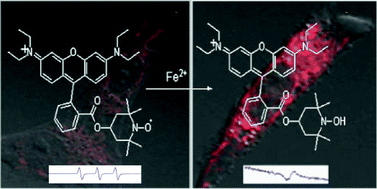Reaction-based turn-on fluorescent probes with magnetic responses for Fe2+ detection in live cells†
Abstract
Iron is the most abundant nutritionally essential transition metal found in the human body. It plays important roles in various biological processes such as oxygen delivery, electron transport, enzymatic reactions and DNA synthesis and repair. However, iron can also catalyze the production of free radicals, which are linked to quite a few diseases such as cancer, neurodegenerative diseases, and cardiovascular diseases. Both iron deficiency and iron overload are related to various health problems. Thus, precisely monitoring iron ions (Fe2+ and Fe3+) in biological systems is important in understanding the detailed biological functions of iron and its trafficking pathways. However, effective tools for monitoring labile Fe2+ in biological systems have not yet been established. Reported herein are turn on, reaction-based coumarin and rhodamine-linked nitroxide probes (Cou-T and Rh-T) for selective detection of Fe2+ in solution and in living cells. Rh-T displayed a unique change in the EPR signal as well as enhancement of the fluorescence signal resulting from a specific redox reaction between the probe and Fe2+. The turn-on fluorescence response towards Fe2+ allows the subcellular imaging of endogenous Fe2+ as well as imaging under conditions of external iron supplementation or depletion, with a labile Fe2+ pool located in the mitochondria of human fibroblast primary cells. The detection and mechanism were verified by the magnetic properties of the probe via electron paramagnetic resonance (EPR) spectroscopy in solution and in cells.


 Please wait while we load your content...
Please wait while we load your content...